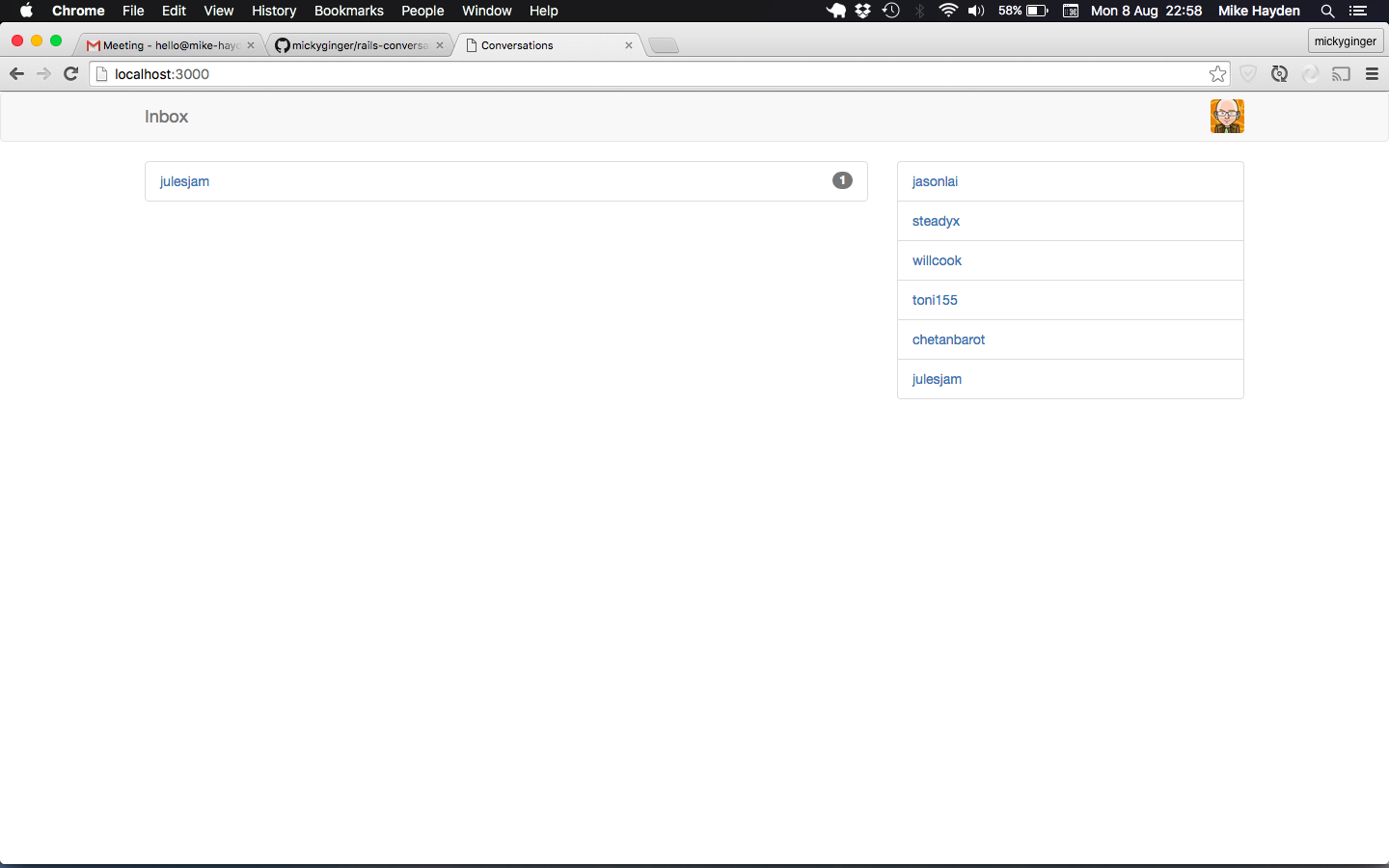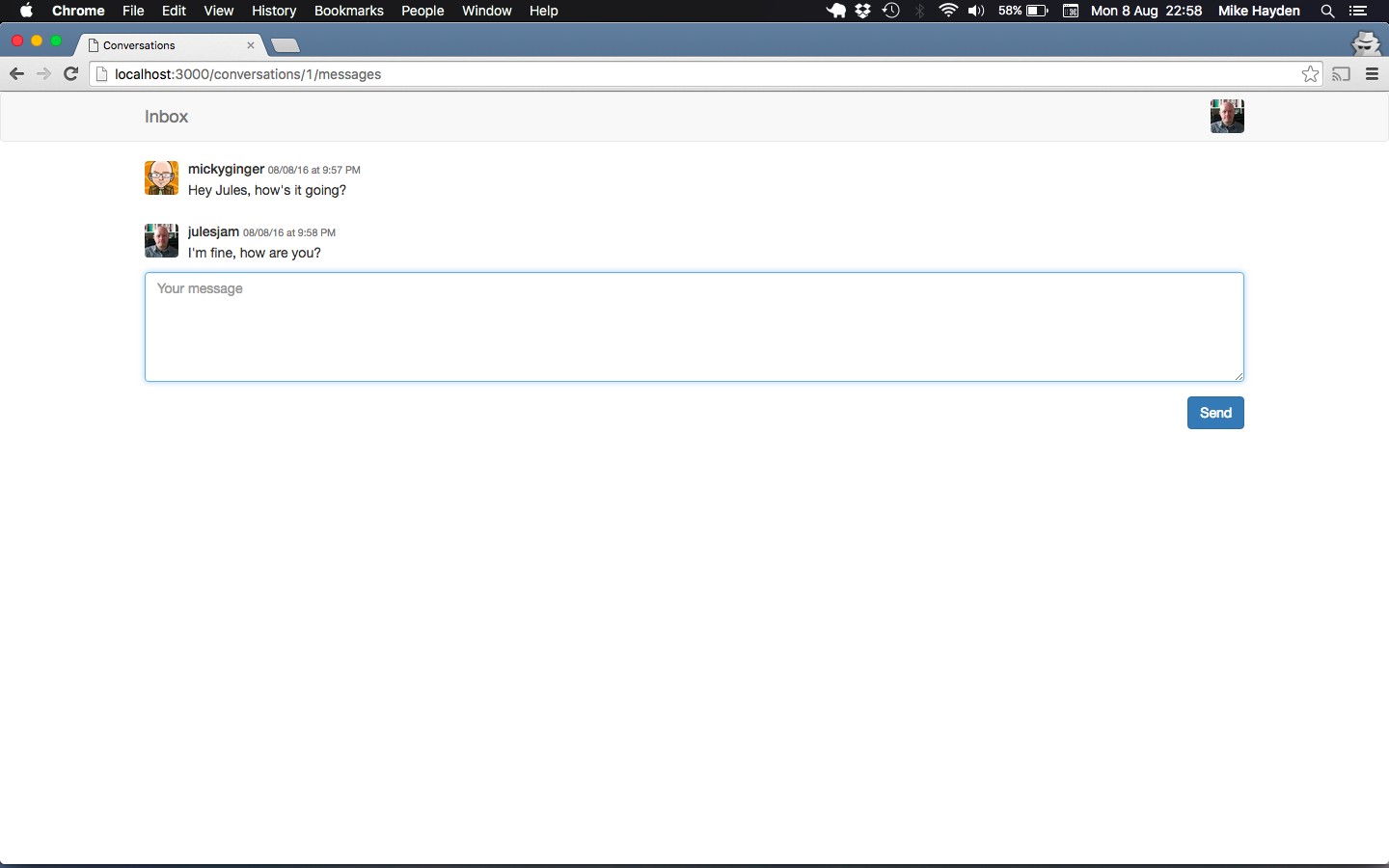Note: This app was lifted almost line by line from an excellent article by Dana Muller. I've made a few changes to her solution, but I highly recommend reading the article.
Note: This guide assumes you've already implemented a user authentication system with BCrypt.
The system requires 3 models: User, Message and Conversation. The conversation is simply a container for messages. It is essentially a relationship between two users. The system we are going to create will effectively mimic a phone text message system, where the user clicks on the name of a contact and all of the messages between those two people will be displayed there.
We will not be using scaffold at all throughout this walkthrough, since we only need a few, very specific views.
The conversation model and respective database table is quite unusual, so we're going to build it piecemeal, starting with a custom migration:
rails g migration CreateConversations
This will give you the following migration:
class CreateConversations < ActiveRecord::Migration[5.0]
def change
create_table :conversations do |t|
end
end
endUpdate it as follows:
class CreateConversations < ActiveRecord::Migration[5.0]
def change
create_table :conversations do |t|
t.integer :sender_id
t.integer :receiver_id
t.timestamps
end
end
endThen run the migration with rake db:migrate
Since the sender_id and the receiver_id will both be user ids, we need to construct a very specific model. First we'll manually create the model file:
touch app/models/conversation.rb
Then flesh out the model:
class Conversation < ApplicationRecord
belongs_to :sender, class_name: "User", foreign_key: "sender_id"
belongs_to :receiver, class_name: "User", foreign_key: "receiver_id"
endHere, we've indicated that the sender_id and receiver_id are both ids from the user table. So when we do conversation.sender or conversation.receiver, ActiveRecord will attempt to find a user with those ids.
But wait, there's more...
A conversation will have many messages, so we can add that relationship to the model now as well:
class Conversation < ApplicationRecord
belongs_to :sender, class_name: "User", foreign_key: "sender_id"
belongs_to :receiver, class_name: "User", foreign_key: "receiver_id"
has_many :messages, dependent: :destroy
endWe're also going to add a validation as well. We want to make sure that only one conversation is created between two users, regardless of who is the receiver and who is the sender.
If Sarah starts a conversation with Bradley, Sarah is the sender and Bradley the receiver. If Bradley wants to send Sarah a message, he should use the same conversation that has already been set up between those two users, even though he is now the sender.
class Conversation < ApplicationRecord
belongs_to :sender, class_name: "User", foreign_key: "sender_id"
belongs_to :receiver, class_name: "User", foreign_key: "receiver_id"
has_many :messages, dependent: :destroy
validates_uniqueness_of :sender_id, scope: :receiver_id
endThe scope option limits the uniqueness check.
Note: more info on ActiveRecord validations can be found in the official docs
Finally, we need to add a class method between which will allow us to find the conversation between to users, regardless of who is the sender and who is the receiver. To create a class method with ActiveRecord, we use the scope method, like so:
class Conversation < ApplicationRecord
belongs_to :sender, class_name: "User", foreign_key: "sender_id"
belongs_to :receiver, class_name: "User", foreign_key: "receiver_id"
has_many :messages, dependent: :destroy
validates_uniqueness_of :sender_id, scope: :receiver_id
scope :between, -> (sender_id,receiver_id) do
where("(conversations.sender_id = ? AND conversations.receiver_id = ?) OR (conversations.receiver_id = ? AND conversations.sender_id = ?)", sender_id, receiver_id, sender_id, receiver_id)
end
endHere we have created some custom SQL. Conversation.between will take two arguments, both user ids, and try to find a conversation that has either one as sender OR receiver. We be using this later.
This will be a lot simpler! We can generate the model directly like so:
rails g model Message body:text conversation:references user:references read:boolean
Before running the migration that is created, we need to set read to be false by default. Amend the migration like so:
class CreateMessages < ActiveRecord::Migration[5.0]
def change
create_table :messages do |t|
t.text :body
t.references :conversation, foreign_key: true
t.references :user, foreign_key: true
t.boolean :read, default: false
t.timestamps
end
end
endThen rake db:migrate
We're just going to add a validation to the message model to ensure all of the fields are filled in:
class Message < ApplicationRecord
belongs_to :conversation
belongs_to :user
validates_presence_of :body, :conversation_id, :user_id
endWhile we're here, we can add some formatting to the timestamp, so we can display the time of the message in a more human readable way:
class Message < ApplicationRecord
belongs_to :conversation
belongs_to :user
validates_presence_of :body, :conversation_id, :user_id
private
def message_time
created_at.strftime("%d/%m/%y at %l:%M %p")
end
endDone and done.
The routing for this system is actually very straightforward. We want a conversations index page, which will display all the conversations a user has. We also want a conversations_messages index page that will display all the messages for that conversation.
We can do that very simply like so:
# config/routes.rb
resources :conversations, only: [:index, :create] do
resources :messages, only: [:index, :create]
endYou can see how that has affected your app's routes by typing rails routes in the terminal.
The conversations controller will basically handle showing all conversations, and creating new conversations when needed. It will only need index and create methods.
Lets make this now:
rails g controller conversations index
This will create the controller and an index.html.erb file in app/views/conversations/
Let's flesh out the controller:
class ConversationsController < ApplicationController
before_action :authenticate
def index
@conversations = Conversation.where("sender_id = ? OR receiver_id = ?", current_user.id, current_user.id)
@users = User.where.not(id: current_user.id)
end
endFor the index, we will display a list of all the conversations that the current user has on the go, and a list of the users that are signed up to the app.
Notice that I have added the authenticate method as a before_action. The user must be logged in to view their messages!
Let's now add the create method. First we will check if a conversation already exists between the two users. If it does we will redirect the user to that conversation's messages index page. If not, we will create the conversation and then redirect the user.
class ConversationsController < ApplicationController
before_action :authenticate
def index
@users = User.where.not(id: current_user.id)
@conversations = Conversation.where("sender_id = ? OR receiver_id = ?", current_user.id, current_user.id)
end
def create
if Conversation.between(params[:sender_id], params[:receiver_id]).present?
@conversation = Conversation.between(params[:sender_id], params[:receiver_id]).first
else
@conversation = Conversation.create!(conversation_params)
end
redirect_to conversation_messages_path(@conversation)
end
private
def conversation_params
params.permit(:sender_id, :receiver_id)
end
endThis is where the between method we created in the model comes in to play.
There's only one view we need to create here. Here's a skeleton view which you can amend and style to your liking:
<h1>Inbox</h1>
<ul>
<% @conversations.each do |conversation| %>
<% recipient = conversation.sender_id == current_user.id ? conversation.receiver : conversation.sender %>
<li><%= link_to recipient.username, conversation_messages_path(conversation) %></li>
<% end %>
</ul>
<h2>Users</h2>
<ul>
<% @users.each do |user| %>
<li><%= link_to user.username, conversations_path(sender_id: current_user.id, receiver_id: user.id), method: :post %></li>
<% end %>
</ul>As before we can generate the controller like so:
rails g controller messages index
Here's the completed controller. Take a look, then I'll talk you through it:
class MessagesController < ApplicationController
before_action :authenticate
before_action do
@conversation = Conversation.find(params[:conversation_id])
end
def index
@messages = @conversation.messages
@messages.where("user_id != ? AND read = ?", current_user.id, false).update_all(read: true)
@message = @conversation.messages.new
end
def create
@message = @conversation.messages.new(message_params)
@message.user = current_user
if @message.save
redirect_to conversation_messages_path(@conversation)
end
end
private
def message_params
params.require(:message).permit(:body, :user_id)
end
endWe start by ensuring the user is logged in. Since we are always going to need the current conversation regardless of what we are doing, we can use the before_action hook to pull that from the database.
In the index method, we can pull out all of the messages from the conversation. Since all the messages will be on the page, we can assume the user has read all the unread messages that were sent to her, so we update the read attribute of any messages sent by the other user to be true. After that, we create a new message, ready for the user to add the content.
The create method is standard, we save the message and redirect to the same page, so the user can see their new message has been added to the conversation.
Again, a skeleton view for your consideration:
<ul>
<% @messages.each do |message| %>
<% if message.body %>
<li>
<h4><%= message.user.username %></h4>
<p><%= message.body %></p>
</li>
<% end %>
<% end %>
</ul>
<%= form_for [@conversation, @message] do |f| %>
<div class="field">
<%= f.text_area :body, placeholder: "Your message" %>
</div>
<%= f.submit "Send" %>
<% end %>The only thing here that's unusual is the form_for tag. We're passing two models. This will mean that the form points to the correct url, eg: /conversations/1/messages/
The ideal goal with the MVC design pattern is to have the model take care of all the data, and as much logic as possible, leaving our views and controllers as clean as possible. We can remove the receiver variable from the conversations index page and move the logic into the model:
# app/models/conversation.rb
class Conversation < ApplicationRecord
belongs_to :sender, class_name: "User", foreign_key: "sender_id"
belongs_to :receiver, class_name: "User", foreign_key: "receiver_id"
has_many :messages, dependent: :destroy
validates_uniqueness_of :sender_id, scope: :receiver_id
scope :between, -> (sender_id, receiver_id) do
where("(conversations.sender_id = ? AND conversations.receiver_id = ?) OR (conversations.receiver_id = ? AND conversations.sender_id = ?)", sender_id, receiver_id, sender_id, receiver_id)
end
def recipient(current_user)
self.sender_id == current_user.id ? self.receiver : self.sender
end
endWe've created a new method recipient, which will return the other user (ie. not the current_user) from the conversation. Unfortunately we have to pass current_user into the method since current_user is not available in the model by design.
Note: Some more info about that from http://stackoverflow.com/questions/2513383/access-current-user-in-model
Now we can use it in our view
<h1>Inbox</h1>
<ul>
<% @conversations.each do |conversation| %>
<li>
<%= link_to conversation.recipient(current_user).username, conversation_messages_path(conversation) %>
</li>
<% end %>
</ul>
...Ah, that's much nicer
Finally, lets display the number of unread messages in a conversation. Again, not all the unread messages, just the unread messages that were posted by the other user. Let's make a new method in the model to handle that:
class Conversation < ApplicationRecord
belongs_to :sender, class_name: "User", foreign_key: "sender_id"
belongs_to :receiver, class_name: "User", foreign_key: "receiver_id"
has_many :messages, dependent: :destroy
validates_uniqueness_of :sender_id, scope: :receiver_id
scope :between, -> (sender_id, receiver_id) do
where("(conversations.sender_id = ? AND conversations.receiver_id = ?) OR (conversations.receiver_id = ? AND conversations.sender_id = ?)", sender_id, receiver_id, sender_id, receiver_id)
end
def recipient(current_user)
self.sender_id == current_user.id ? self.receiver : self.sender
end
def unread_message_count(current_user)
self.messages.where("user_id != ? AND read = ?", current_user.id, false).count
end
endGreat, let's update the view
<h1>Inbox</h1>
<ul>
<% @conversations.each do |conversation| %>
<li>
<%= link_to conversation.recipient(current_user).username, conversation_messages_path(conversation) %>
<% if !conversation.unread_message_count(current_user).zero? %>
(<%= conversation.unread_message_count(current_user) %>)
<% end %>
</li>
<% end %>
</ul>If there are unread messages (ie. the unread_message_count is not 0), then we can display them on the screen.
Note: if you're using bootstrap [http://getbootstrap.com/components/#list-group-badges](a list group with badges) might be useful here.


